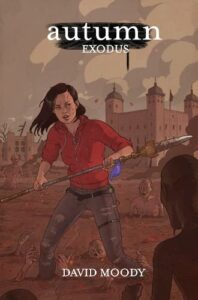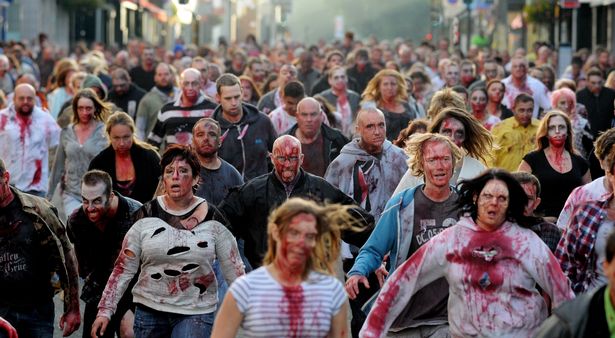Today is the second in a series of columns by David Moody to mark the release of Autumn: Exodus, the final book in his acclaimed Autumn series. Moody has been writing about the end of the world for almost thirty years. His novel, Hater, was optioned for film by Guillermo del Toro.
Last time I was here, I talked about how things had changed for me as an author writing zombie novels across several decades. This time, I’m looking at the changes the zombie sub-genre itself has gone through in that time.
Here’s a statistic that will put things in perspective (and perhaps go some way to explain the zombie fatigue that’s set in with a lot of folks). Using a very unscientific method—counting the number of films per decade on a Wikipedia page that lists zombie movies (https://en.wikipedia.org/wiki/List_of_zombie_films)—I’ve calculated that close to ten times as many zombie movies were made in each of the complete decades of the 21st century so far, as were made in the whole of the 20th century. Here are my figures for completeness:
1900–1999: 196 zombie films
2000–2009: 182 zombie films
2010–2019: 202 zombie films
Of course, there could be any number of reasons for this. There’s no question that there are more films being made now, not least because of the quality and availability of technology. We’re all carrying around movie-quality cameras in our pockets, after all. As a control, I looked at the comparable figures for vampire movies as well to try and see if they’d seen similar growth. In terms of totals, zombies have a clear edge with almost 600 films listed against almost 400 vampire flicks, but here are the growth stats:
1900–1999: 207 vampire films
2000–2009: 87 vampire films
2010–2019: 72 vampire films
So, as you can see, movies about our fanged friends haven’t seen the same exponential growth in number as zombies.
Okay, no more maths. You get the point: a HUGE number of zombie-themed films have been made since the turn of the century. The undead have seen a remarkable surge in popularity that’s been maintained for more than twenty years, a heck of a winning streak.
I touched on why that might be the case previously. I think zombies are all too often seen as an easy option. Want to make a zombie movie? Get a bunch of your mates together—a little face-paint and fake blood and a whole lot of shambling, and there you go: an instant zombie horde. Some people take this to extremes. My friend Ryan Fleming decided to make a zombie movie 10 years ago and managed to persuade 1000 folks to play dead. The full story is here (https://www.phoenixfm.com/2013/09/15/zombies-take-over-brentwood-otherwise-everything-normal/) and though hard to find, his film Welcome to Essex is well worth looking out.
No disrespect intended to Ryan or any of the countless other low-budget filmmakers, but that’s just about all you need to get going. You’ll need a plot, of course, and that’s another aspect that makes the living dead a shoo-in: you can put zombies into literally any situation and have a story—any time, any place, anywhere.
 But a lot of zombie tales limp along on the weakest of premises because their creators know that as soon as the flesh-eating, bloodshed, and violence starts, a good proportion of their audience will be satisfied and won’t much care about anything else. The same is also true in print, and over the course of the last twenty years, indie publishing has seen as profound a revolution as indie filmmaking.
But a lot of zombie tales limp along on the weakest of premises because their creators know that as soon as the flesh-eating, bloodshed, and violence starts, a good proportion of their audience will be satisfied and won’t much care about anything else. The same is also true in print, and over the course of the last twenty years, indie publishing has seen as profound a revolution as indie filmmaking.
Through luck more than judgement, I found myself riding the first wave of change. Still stinging from the fact my first book bombed and didn’t make me a literary sensation and overnight millionaire, I took a different approach when I was ready to release Autumn. I’d recently taken my first hesitant steps online, and I decided to give the book away. Hell, I thought, it’s not about money—it’s about getting as many people as possible to read what I’ve written. As I mentioned last time, the gamble worked—the book took off and led to sequels and a movie. In hindsight, the timing was everything. Free books were a new phenomenon back in the early 2000s, and I did it just as people were starting to develop an interest in eBooks. Suddenly, publishing was no longer the preserve of a select few—it was open to everyone. As interest grew, indie publishing became simpler and more effective—print-on-demand meant that physical as well as electronic books were now a possibility, and the rapid growth of Amazon and other online marketplaces gave indie authors a platform that previously didn’t exist to anyone outside the sphere of traditional publishing.
Just as with films, the zombie infection spread through the written world with a similar speed and voracity. Again, that’s testament to the extreme adaptability of the living dead. I’m yet to think of a scenario that you couldn’t drop zombies into. Over the years they’ve managed to get their decaying little mitts into everything and everywhere—from historical dramas to futuristic thrillers, from the centres of crowded metropolises to the most isolated of outposts. When you think about it, everywhere we are, they are.
And that can be a double-edged sword. There have been plenty of books published where the most tenuous of plots exists for no other reason than to move thinly-drawn characters on from one zombie kill to the next, where the calibre of the bullet is more important than the reason the shot was fired, where success is measured in litres of blood spilled rather than survivor numbers.
But not everyone is satisfied with blood and guts and violence. For interest to have been maintained and for the zombie genre to have survived for so long, it’s also needed to innovate and evolve. More about that next time.
DAVID MOODY
Buy David Moody’s books









